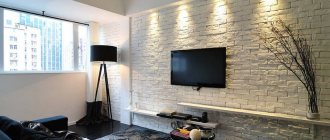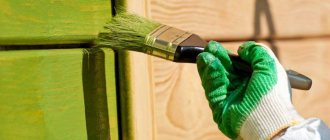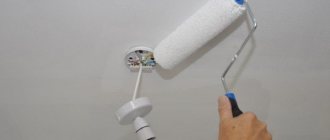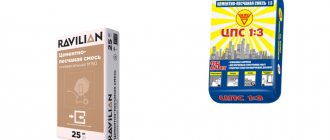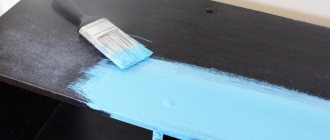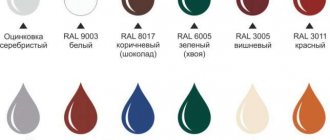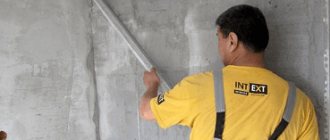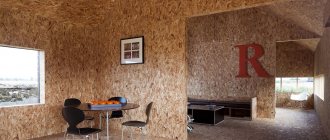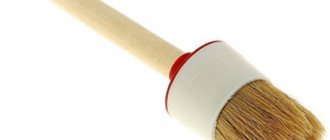The quality of the exterior decoration of a house is visually determined only by assessing the level of wall painting.
It doesn’t matter whether a complete layer-by-layer processing was carried out, the entire complex of work was done from scratch, or only cosmetic painting of the walls was done - outwardly everything looks exactly the same and for most it means the same thing - repairs have been made.
This is the main property of facade paint - the creation of a decorative outer layer that makes the appearance of the building new and elegant . Sometimes simply repainting the walls a different color looks like a complete change in the appearance of the house, affecting all elements of the architecture, although there were no structural additions or other interventions.
At the same time, painting the walls of a dacha touches on much more important operational issues, not limited to external effects. In this article we will talk about how to paint a private house with your own hands (+photo) and how to properly care for the surface.
Why do you need to paint the facade?
Painting the facade is the application of an external decorative and protective layer of the outer coating . In addition to purely visual changes, the paint layer creates a durable protective film that cuts off the wall material from the penetration of water from outside, from temperature influences, and eliminates the appearance of mold, mildew or algae.
In addition, an important ability of facade coatings is vapor permeability , i.e. the ability to remove moisture from the inside at the capillary level without the possibility of absorption from the outside.
Paints that do not have high vapor permeability are unsuitable for outdoor use, since steam, which does not have an outlet, begins to accumulate inside the walls, causing them to become wet, and ultimately the moisture freezes, expands and tears the walls from the inside.
Therefore, the correct choice of paint is a very important point; the durability of materials and structures, the possibility of proper operation of the wall pie, and only last but not least, the decorative qualities of the finish depend on it.
How to carry out protective treatment
How to paint the facade of a house correctly? Before painting, it is necessary to treat the walls with special compounds. There are several types of compositions:
- penetrating – penetrate into the wood structure;
- surface – form a protective film;
- thermal - change the properties of wood.
Penetrating treatment is more popular; it is carried out using compounds called impregnations. They protect wood from moisture, mold, microorganisms and fire.
There is a decorative impregnation, after its application the wood does not need to be painted. It emphasizes the texture and gives a certain shade to the wood. If you were going to paint a house made of timber, decorative impregnation will be enough for it.
Often, impregnations also act as primers; they improve adhesion and reduce paint consumption.
If the surface is well cleared of paint, you don't have to prime the walls. To determine the strength of the paint remaining on the wall, apply clear stationery tape to it and rip it off the wall with a sharp movement. If there are no bits of remaining paint stuck to the tape, the wall is ready to be painted.
You can prime the walls with a primer, it protects the wood well, but this coating takes a very long time to dry. The best option for exterior work is to use a primer recommended by the manufacturer of the façade paint. Therefore, first choose a paint to renovate the facade of your house.
Painted wooden house
Types of facade paints
Facade paints have approximately the same structural composition:
- Base (film former).
- Fillers.
- Pigments.
- Solvent.
Based on the type of paint base there are:
- Mineral. The basis is derivatives of cement and lime, which are inexpensive materials.
- Silicate. They are produced on the basis of liquid glass with additives. They have low water-repellent ability.
- Silicone. Expensive paints based on silicone resins. They have an excellent set of properties - high vapor permeability, completely impervious to water, very elastic. The reason for its rare use is the high cost of the material.
- Acrylic. One of the most common paint groups, it has good qualities and a relatively low price.
By type of solvent:
- Aquatic.
- Using organic solvents (white spirit, etc.).
IMPORTANT!
The choice of one or another type of paint is determined by the wall material and operating characteristics, climatic and weather conditions of the region.
paints and varnishes
0 votes
+
Vote for!
—
Vote against!
Without the final stage of painting the facade, no matter what the architectural design, the building looks imperfect. The prepared facade of the house for painting is brought to the final stage, when the layer of finishing plaster has dried and the color scheme has been selected. Painting work is carried out before the onset of frost, which will help preserve the plastered walls. The updated facade will protect the house from adverse external influences, significantly transform and update it. We offer secrets of technology and examples of painting the facade of a private house to use them to update your estate or complete construction.
Table of contents:
- How to prepare a facade for painting?
- General tips for choosing the color and type of façade paint
- How to choose the right type of paint?
- What makes painting a façade difficult?
- Preparing the facade for painting
How to prepare a facade for painting?
Any facade paint is specially designed for facade cladding, but the surface to be painted requires careful preparation. If the wall of the house crumbles or has defects, it must be:
- strengthen;
- level;
- cleanse;
- prime;
- impregnated with an antifungal composition.
Not all materials from which external walls are built in private houses require plastering and painting. However, this may be a conscious choice if the entire architectural ensemble of the estate must be consistent with the general style and color scheme. Exterior walls are most often made from the following materials:
- wood (log house);
- reinforced concrete panels;
- brickwork;
- shell rock;
- cinder block;
- adobe;
- cast slag concrete, etc.
For each material, a specific type of paint and varnish coating is selected, which are produced on different bases.
Exterior finishing and painting are not necessary for all surfaces; for example, facing bricks with high decorative properties do not require additional painting. The choice of facade paint depends on the wall material. Today the following external surfaces are quite common:
- textured and decorative plaster;
- siding;
- wild stone;
- aluminum glazing;
- metal-plastic facing panels;
- blocks made of composite materials, etc.
Attention: Equipment for painting facades depends on the complexity of painting and the number of floors. In private houses up to the 2nd floor, a stepladder and a ladder are used, and for processing and painting, installation cradles or equipment for industrial climbing are needed. In such cases, contact specialized companies that specialize in painting the facade of an apartment building.
The prepared façade is the surface:
- no dents or bumps;
- without crumbling finishing materials;
- smooth and dry;
- primer-impregnated wall and adjacent surfaces.
Advice: When choosing a material for painting on the facade of a house, it is important to be guided not by your own preferences, but by general recommendations on technology, so that:
- extend the service life of the coating;
- eliminate bald spots and desquamation;
- washing off paint under slanting downpours;
- cracking due to temperature changes.
Attention: On combined surfaces where various building materials were used in the decoration of the facade, it is often difficult to choose a universal dye that is most suitable for high-quality coverage of all textures. Then you have to seek advice from specialists who must go to the site and give recommendations on the spot. Advice over the phone will not work here!
General tips for choosing the color and type of façade paint
Often, even the most daring experimenters are not always ready to radically change the facade of a house, although the modern color palette for painting the facade of a house is impressive. If you put aside your conservatism and prejudices regarding the ideal design and look at the illustrations, it is obvious that a black or red house is also beautiful in its own way! For example, painting the facade of a house, photo:
How to choose the right main color and its companions? Take into account simple advice from experts:
1. When painting houses and facades, the color combination should be in harmony with the landscape design and patio design at any time of the year. The same shade looks different in winter and summer, on the shaded north side and the south wall exposed to direct sunlight. Lush vegetation often contrasts with the facade of the house, but a green house looks ridiculous on a snow-covered plain.
2. Pay attention to the color of the roof when painting the facade of a private house. It is also easy to repaint if necessary, and the roofing material is suitable for these purposes. If the house is expecting a new roof, then it is better to match its shade to the color of the updated facade. It is better if the roof tone is darker, but is in harmony with the overall decoration.
3. It is also important to take into account the stylistics of architecture, since classics do not tolerate extremes and liberties.
4. The shade of the walls should emphasize the natural texture of wild stone or decorative plaster as much as possible. White and cream trim matches the white railings and window frames. Dark colors should go well with the wild stone of the foundation, wooden door or plank deck.
5. The beauty of a sleek facade is in the detail, and a little contrasting finishing never hurts, especially if the structure is large.
6. You shouldn’t experiment unnecessarily with painting individual wall fragments when painting the facade of a house with your own hands, but it is quite appropriate to highlight:
- individual structural parts;
- slopes;
- gables;
- pilasters;
- stucco;
- foundation;
- decorative elements;
- columns or supports;
- shutters;
- arched fragments;
- front entrance, etc.
7. It is undesirable to use many shades or colors; it may look ridiculous. The classic combination is 3 colors, where the lightest or darkest is the background, the rest complement the range. Also, a lot depends on the proportions of the color; they can lighten or make the structure heavier.
Tip: You can check the combination of shades on a preliminary sketch - take a photograph of the house and try 3-4 options for painting the facade of the house. It's like a child's coloring book. There are also special computer programs where you can play with color. This is the easiest and safest experiment.
How to choose the right type of paint?
To decorate the facade, organic and inorganic dyes are used, which have different structures and chemical compositions. It all depends on what surface they are intended for:
- mineral paints for painting the facade of a house fit well on a concrete wall or brickwork;
- a modified silicone base will revive and strengthen the old façade;
- acrylic paint is suitable for concrete products and decorative plaster;
- For structures made of wood and metal, universal resin-based paints are selected.
Each paint has its own properties, and some are washed out under the slanting rays of downpours, others fade over time in the sun. The thermoplastic base softens from overheating, and on some surfaces painted with dispersion paint on the north side, moss or fungus takes root well. And silicate ash paint is very reliable, but it is toxic when working with it.
Lime- and silicate-based paint has good vapor permeability, that is, it breathes, absorbing and releasing moisture. Other dyes create an elastic glossy film and are impervious to water. But from direct sunlight, the walls soften, the paint sticks and collects dust on its surface, which is difficult to remove later.
Attention: Modern organosilicon compounds with high vapor permeability repel water and do not erode under the influence of adverse weather factors. They do not form pollution, which is very important when the wall of the house is located along the roadway of the street.
What makes painting a façade difficult?
When starting to paint the facade of a house with their own hands, an ignorant beginner in this matter rarely realizes the scale of the undertaking. Lack of knowledge on wall painting technology, lack of convenient tools and devices for moving along the wall, limited budget and lack of experience create difficulties and lead to mistakes. Because of this, the need for new expenses arises, instead of saving on the work performed independently.
Attention: Do not rush to complete the work if something fails on one wall. It is much easier to draw the right conclusions or correct mistakes on a small fragment of the facade than to repaint the entire building.
Work on painting external walls requires compliance with all technological standards and phased implementation. If facade work is carried out on a prepared wall, after the end of the season favorable for repair work, in frosty weather or during a rainstorm, the result will not be what was expected.
Water is a factor that cannot be ignored. It can damage the exterior painted foundation or basement floor. A house that does not have a well-thought-out storm drainage system will undergo a kind of waterproofing and waterproofing test after each heavy rain. The service life of façade paint on such walls can be halved.
A poorly prepared base is another point that is most often missed by “masters” who are ignorant in painting external walls. Depending on the region, groundwater and sediments may have different levels of acidity. This is also important to consider when choosing a primer paint. It is difficult to check the acid-base environment of the wall, but when water corrodes the facade, it is noticeable. The walls of such houses have to be additionally impregnated and strengthened.
Attention: Any paint fits perfectly only on a primer! Some paints for painting the facade of a house are applied in 1 layer, but 2 layers look better. In this case, the layers should be of different consistencies; it is better to make the second one a little thinner, eliminating bald spots and thick strokes.
Preparing the facade for painting
Before applying the primer, it is important to prepare the wall:
- clean from old paint, grease stains, soot and dust;
- wash away stains, dirt and splashes;
- remove rust stains;
- fill up nail marks and minor defects;
- complete the work of plastering the walls;
- Allow the façade to dry thoroughly.
Tip: Most dirt can be easily removed from the surface of the façade with a wire brush and a small spatula. Sometimes it makes sense to blow the crumbling surface with compressed air, and then plaster it with finishing or textured plaster.
Before applying the primer, if the surface of the walls is too smooth, rub it with emery cloth in a circular motion. Some primers contain fine-grained sand or other suspension - this promotes better adhesion. On such a vertical surface, the paint is well distributed and lies evenly, and does not just flow down, as happens with a perfectly smooth base.
If the plaster has fallen off in places, it is worth checking all the walls for integrity - tapping them with a wooden hammer. Those places where there are internal cracks and swellings from fungus will definitely fall off, sometimes entire walls. Don't regret it - it would have happened a little later, but after painting. These places will have to be plastered or sealed (with clay, cement mortar).
Golden rule: The more thorough the preliminary preparation of the walls, the better the quality of the facade painting!
The prepared and primed surface can be painted:
- special paint sprayer;
- household spray bottle;
- vacuum cleaner (if you have a special kit for painting walls);
- universal industrial machine for outdoor work;
- paint roller and wide brush.
Most dyes are produced in special white or cream-colored containers, into which the coloring pigment is added and mixed well. Before preparing the paint, it is important to study the instructions, which indicate whether you need to add a solvent, and in what proportion the pigment is added.
Attention: It is very important to maintain the proportion of pigment and base when adding new portions of paint to your work!
Facade work must be carried out wearing a respirator and protective work clothing. Hands and feet must also be protected. It is equally important to think about moving along walls and securing yourself so as not to fall and get injured. It is very convenient to work together with a helper who supplies paint and tools, moves a stepladder, cradle, winch and other devices for moving along the walls. You will find many useful tips here - painting house facades, video:
Water based paints
Water-based (water-dispersed) paints are an emulsion of small particles of a working mixture in water . When applied, water is partially absorbed into the base, and partially evaporates, leaving a coating film that, after drying, does not react at all to the influence of water.
This composition has important advantages:
- No smell . This is the main advantage of water-based materials, which often determines the choice of users.
- No strong shine . The surface has either a deeply matte or soft silky sheen. Visually matte surfaces look smoother, do not glare and create a noble and stylish appearance of a house or cottage.
- Availability of excellent working qualities of the coating . Almost all water-dispersed paints have a full set of properties that allow them to successfully perform their functions.
- Possibility of tinting in any color . All water-based compositions are available in the form of two or three types - bases. Usually the first one is white and can be used as an independent paint or tinted in some light shade. The second and third are transparent, intended for tinting into denser and brighter colors.
- Low consumption . Most water-based formulations have high hiding power and low (relatively) density, which allows them to cover a larger area than other types of paints.
- Quick drying . Unlike other types, water mixtures dry within a few hours, allowing for maximum speed of work.
- Plain water is used as a diluent, which makes the work much easier (and cheaper) and helps keep the working tools in order and clean.
The disadvantages of water-based paints are:
- Contraindications for use on metal substrates.
- Weather restrictions, cannot be applied in rainy weather.
- The stains that appear are difficult to erase, and repeated washing of the walls spoils the appearance of the coating.
The disadvantages of water-dispersed facade paints are not critical; the popularity of such compositions is steadily growing.
The most popular manufacturers of acrylic, oil, water-based paint
Galamix. A Russian manufacturer that brings a significant amount of products to the market. They produce acrylic matte paint, textured facade paint for wood surfaces and textured paint for mineral facades. Acrylic paints are environmentally friendly, their service life is about 8 years. Textured paints do an excellent job of visually smoothing out any irregularities in the surface of the facade. The price from this manufacturer is about $1.2 per liter.
Dulux. Manufacturer of paints from England, producing water-based paints, acrylic, textured and matte quick-drying organic types of paints. Dulux paints are strong and durable. They guarantee protection of the facade from the occurrence and growth of fungus and mold. The service life is about fifteen years, and the cost is about $5 per liter.
Caparol. German paint production. We can say that this is the most popular type of paint. Famous for its impeccable quality. Suitable for painting any surface. Has an affordable price. Paints with thermal insulation properties are produced. Wide range of colors.
The well-known Caparol paint logo
Alpina. Famous for German quality and affordable price. It is used to paint plastered, brick, concrete and LShSU facades. It has excellent hiding power and lightfast shades. Reliably protects the facade.
Snowball. High-quality paint from a Russian manufacturer. It can be used to paint cement, lime, concrete, previously painted and plastered surfaces. It is characterized by high resistance and durability, resistant to natural phenomena. Wide palette of colors.
Beckers. A Swedish manufacturer that produces a whole series of facade paints. They are engaged in the production of matte water-based latex paints, acrylic paints, acrylate latex paints and alkyd-oil paints, to which linseed oil is added. They are well suited for painting concrete, metal and wood surfaces. Non-flowing and fits perfectly. They cost from $15 per liter.
Paint Backers
Ticurila. Swedish paint manufacturer. It produces acrylic-silicate, silicate, lime and base types of paints. They are good for covering lime, brick, concrete and cement surfaces. The company has also developed a whole series for painting wood surfaces. They have a wide palette of colors (about 190 types). The cost starts from $1.4 per liter.
PaintTicurila
Svyatosar. Russian manufacturer of facade paints. The products meet all current requirements for facade paints. They are engaged in the production of acrylic abrasion-resistant, restoration and frost-resistant paints. They also produce paints that can be used to paint metal surfaces.
Baumit. One of the leading Austrian brands, which has been on the market for more than 20 years. It produces a whole series of silicone paints for facades, which can be used to restore old houses, sanitize coatings, decorate new facades and paint thermal insulation systems. They cost from 1.2 dollars per liter.
Organic based paints
Organic-based materials are more traditional because they have been used for a long time. Many users prefer them precisely for this reason, not trusting the apparent fragility of water-based compositions.
Organic-based paints have many advantages:
- Durability of the coating.
- Elasticity, the ability to compensate for minor movements during shrinkage.
- Water resistance.
- Frost resistance.
- Vapor permeability.
- Compatible with most surfaces , excellent adhesion to metals.
- Tolerance of sudden temperature fluctuations.
- Durability.
- Possibility of painting at low temperatures or high humidity.
The disadvantages include:
- Pungent odor upon application and for some time after drying.
- Drying one layer requires a long time - two days; for subsequent layers, the drying time increases.
- The need to use solvents, which increases costs.
Organic solvent paints have a strong shine. This property causes different attitudes - for some it is very desirable, others consider it a disadvantage.
NOTE!
In addition, a significant disadvantage of organic solvent paints is the strong odor , which is very poorly tolerated and can cause poor health in some people.
This circumstance reduces the competitiveness of such paints compared to water-based paints, although the other qualities of the material are quite successful and make it possible to create a durable and durable coating.
Reasons for the need to stain wood
Why is it generally necessary to treat wood with various paints and varnishes? It would seem that the natural texture of wood is attractive in itself, and in most cases there is no particular need to embellish it? And all this is due to the fact that impregnation and painting of wood is capable of preserving its physical and aesthetic properties for the longest possible time, such as integrity, strength, warmth, environmental friendliness of the material and the beauty of its textured pattern.
As you know, the first enemy of wood is moisture, which, when it penetrates the structure of the material, has a destructive effect on its fibers. As a result, they swell and deform, losing elasticity and strength. Inside a house with damp walls, various fumes that are unpleasant for the senses inevitably dominate, which easily permeate the structure of the wood. In addition, dampness always “kicks off” the biological decomposition of wood, causing the appearance of mold and blue stains, which, in turn, in addition to creating an unhealthy atmosphere in the premises, also weaken the strength of the building material.
Paint and varnish products, as well as special protective compounds, are primarily designed to protect wood from negative external influences and preserve its structure from destruction. And, of course, the task is always to preserve the aesthetic texture of the wood unchanged or to decorate it in accordance with the intended interior design.
How to choose façade paint for a specific surface?
- First of all, to correctly select the outer covering, you should take into account the base material . Most façade coatings specialize in concrete (including after wall insulation with foam plastic), brick, aerated concrete and plasters of various compositions. At the same time, water-based paints are not always suitable for wooden surfaces and are completely unsuitable for application to metal (steel) substrates, which is the main difference from paints based on organic solvents, which serve as reliable protection for such substrates.
- The second selection factor is surface quality . The presence of shine and the color of the walls directly depend on the composition of the paint used for exterior decoration. Water-based mixtures have lighter tones and a predominantly matte surface, while organic-based materials make it possible to obtain coatings with a hard shine in dense tones, and the choice of color and its tonality is much wider than that of water-based paints.
- At the same time, we must not forget about the operating conditions of the building - in areas with high levels of atmospheric pollution from various industrial or other substances, dust or the presence of large amounts of exhaust gases (industrial or close to large highways), paints with high water-repellent ability should be used , allowing you to safely endure periodic cleaning the walls. For regions with frequent rains, this choice is also relevant, since the penetration of rainwater into the wall material threatens their destruction.
We paint the facade with our own hands: useful recommendations
Follow the simple recommendations given below; the process of painting the facade of a private house will not cause you any difficulties, while the result will certainly meet your expectations.
So, what you need to know to successfully paint a house yourself:
- Start painting the walls from the corners of the house - the areas that are in plain sight.
- Use thin brushes of suitable sizes for painting in hard-to-reach places.
- Protect door and window openings from paint. This can easily be done using masking tape, a special fat mixture or newspapers soaked in water.
- Considering that paint can run off the rollers during painting, the base should be covered with a layer of material last.
- Choose suitable weather for painting with a favorable forecast for the next few days to avoid damage to the paint as a result of precipitation.
- Paint facade decorative elements, window and door openings in a different color to create a unique design.
In conclusion, we note that painting a facade with your own hands is an exciting activity that requires a certain amount of patience and effort. If you have these qualities, and are also looking for opportunities to realize your creative potential while saving money on painting services, then feel free to get down to business.
Which façade paint is most optimal?
The optimally selected material must best comply with all existing conditions - operational, climatic. In addition, the decorative qualities of the coating are important, since they are primarily assessed when looking at a freshly painted house.
Recently, user preferences are increasingly given to water-dispersed compositions , which is understandable by their properties. The most important of these is the absence of odor.
The ability to remove paint stains with plain water is also important - an important plus, since solvents can also remove the necessary substances, which will lead to damage to objects accidentally stained with paint.
Benefits of painting walls
First of all, painting wooden walls reduces hygroscopicity. The beams do not absorb moisture, which increases their service life.
In addition, the painted facade is protected from ultraviolet radiation, which prevents the exterior of the house from darkening. Correctly carried out painting eliminates the possibility of the development of putrefactive processes, the appearance of mold and bark beetles.
Painting a wooden house can not only protect the logs from rotting and exposure to weather factors, but also renew the building itself. Old buildings that have lost their former appearance are especially in need of this.
How to paint the outside of a house? Technology (1 video)
Preparing the wall surface for painting
For painting you will need a clean, dry wall surface.
To prepare you will need:
- Disconnect all hanging structures - brackets, awnings, lights, air conditioners, etc.
- Remove trim from windows or doorways.
- Inspect the walls, determine the degree of wear of plaster or other materials.
- Detected defects are puttied; in case of large quantities of peeling or shedding, it is recommended to apply a leveling plaster layer.
- Some types of facade paints require preliminary priming.
CAREFULLY!
Freshly applied cement or lime plaster must be allowed to sit for 4 weeks (minimum) before painting to complete crystallization of the layer and complete chemical processes within the plaster.
Preparing the surface
Before applying paint, the walls should be prepared, this will guarantee the durability and strength of the applied coating. First, we inspect the surface, if the old paint is tight, there are no chips or dents, it is enough to clean it of dust and moss. Wipe with a stiff brush, or better yet, use a pressure washer to remove all dirt quickly and easily.
If you notice that the surface of the walls is affected by moss or mold, treat the surface with a liquid bioprotective preparation. This is necessary to prevent mold from penetrating deep into the coating.
If there are places on the surface that require plastering, then it’s time to do it. We apply plaster to uneven areas, fill cracks and clean them.
A sandblasting machine is necessary to remove old paint in large volumes, for example, from all sides of the facade. But remember, after plastering the facade, it takes a long time to dry, about 1 month.
You can test the strength of old paint; to do this, take tape and stick it to the surface, after a minute, sharply remove it. If there are fragments of the base left on the tape, then you need to remove the old coating, apply plaster, then primer.
Let's summarize the stages of preparation:
- Cleaning from dirt, dust, mold and moss. We apply bioprotective agents against mold and mildew.
- If necessary, we perform partial or complete plastering and smooth out uneven areas.
- Apply the soil mixture.
Facade painting technology
Painting work is carried out in dry, windless weather.
The air temperature should be:
- For water-based paints - from +5° to +30°.
- For compositions based on organic solvents, the temperature range expands to the lower side (there are brands of paints that allow use down to -20°), but due to the strong odor, use in hot weather is difficult.
Paint is applied either mechanically - spray gun, air or airless spray, or manually using a roller or brushes.
IMPORTANT!
Before applying paint, be sure to carefully read the application method and additional working conditions in order to avoid possible mistakes.
Depending on the type of paint, the surface must be covered entirely at one time (mainly, such conditions apply to water-based coatings, since the junctions of different layers are very noticeable), or interruptions in work are possible (paints based on organic solvents).
Most often, the surface is painted in two layers, the interval between applying the second layer of paint is usually 16-24 hours.
We paint the house with our own hands: technology and features
To paint facades, you may need a painting machine (especially indispensable if we are talking about large surfaces), a roller, a paint trough, brushes of different sizes, and masking tape.
The technique of painting external walls with your own hands is similar to the technology of applying paint to the internal walls of a building. That is why it is built on basic painting operations. Let's look at the nuances of painting using a spray gun and a hand roller.
Electric spray gun. Once the surface of the walls is ready, you can proceed to painting. Using an electric spray gun is much more convenient than a roller, especially if you need to paint large areas in a short time. Applying paint this way is easier, more interesting and convenient. The coating is applied in a perfect thin layer without drips or streaks.
Please note that spray gun painting is only possible at the appropriate paint viscosity level, which is usually indicated on the packaging.
If you decide to paint the facade with ordinary rollers, then take care of several attachments for different sections of the walls and a wide portable ladder or scaffolding.
You need to apply paint with a roller at different angles:
- obliquely;
- vertical;
- horizontally.
You should paint the facade with a roller yourself using the following technology:
- The paint is placed in the tray.
- The roller is soaked in paint and then rolled over its grooved surface to remove excess.
- The stripes are applied not at the joint, but overlapping each other by several centimeters to obtain a uniform color coating.
As a rule, almost all facade paints are applied in two thin layers, except for lime paints, which will need to be used to paint the wall in three layers. Each new layer is applied after the previous one has dried. Metal elements on the surface can also be painted after first treating them with oil paint.
Tips for caring for painted surfaces
Maintenance of façade coverings is minimal. No action is required other than occasional hosing to remove dust.
The application of any protective compounds or other actions aimed at improving the condition of the coating is not used, since the quality and properties of the coating fully meet all requirements and do not require additional measures.
Facade paints, with all the breadth of assortment and variety of types, perform the same task. Since they are created precisely for this purpose, the difference in properties is not critical and consists only of some positions.
Water-based paints and materials based on organic solvents are able to fully satisfy all requests and provide high-quality protection of walls from external destructive factors, as well as decorate the house and create a stylish and neat appearance.
How to paint the outside of an old wooden house
If the house is new, then the main selection criterion is the type of wood used during construction. It will be enough to buy oil or acrylic paint. However, if expensive wood was used, and it is necessary to preserve its beautiful structure, then it is best to paint it with an antiseptic.
If you need to paint the outside of an old wooden house, then before choosing a paint, you need to find out what it was previously coated with.
You can only paint with the type of paint that was used before.
This is done so that when painting, the destruction of the new layer does not begin due to the heterogeneity of the surface being coated. To recognize the type of old paint, you need to cut off a piece of it. The oil one will crumble and collapse, while the acrylic one will curl up.
Comparison of painting with other types of finishes
For analysis, we will take the most popular materials and compare them according to the most noticeable parameters during operation. From the table you will see that paints for wooden facades are not a panacea for all occasions, but in many respects they are better and more practical than, for example, siding or ventilated facades made of porcelain stoneware.
| Dye | Siding | Block house | Brick | Porcelain tiles | |||||||
| Decorative properties | Perfectly preserves the texture and characteristics of the wood surface | Completely hides the base | High, imitates a rounded log | Completely covers the tree | Very decorative | ||||||
| Easy to install and apply | Very easy to apply, just need a brush or roller | Difficult to install, requires special tools | Difficult installation | Difficult installation, requires a concrete foundation | Difficult installation | ||||||
| Price | Cheapest finishing option | More expensive than any type of paint | More expensive than siding | One of the most expensive | As good as brick | ||||||
| Durability | 6-10 years | 20 years | 10 or more years | 50 years | 50+ years | ||||||
| Ability to hide design flaws | Virtually no hiding | Hides completely | Hides | Hides | Hides | ||||||
| Weather resistance | High, but depends on the choice of paint | High | High | The tallest | As good as brick | ||||||
| Resistance to mechanical stress | Resistant only to accidental scratches and impacts. | Does not protect, can be destroyed even with a slight blow | Average | High | The most durable of finishes | ||||||
From the comparison it is clear that the most budget option is painting the walls and other wooden elements of the facade. In terms of mechanical and fire-fighting properties, paint is inferior, for example, to porcelain stoneware or brick, but with the money saved when purchasing material and paying professional builders, you can buy the most modern fire retardants, which make wood completely non-flammable for several decades.
Based on the results of the comparative analysis, you can make a choice in favor of paint. Now you need to make another equally important decision - what paint to paint the outside of a wooden house. Manufacturers produce dozens of types of paints and varnishes intended for external woodwork, but only a few of them may be suitable for a wooden house.
It depends on the:
- house material (timber, logs, blockhouse, lining, chipboard, etc.);
- climate zone;
- type of previous finish;
- budget.
As for paint manufacturers, it is best to focus on well-known brands - Tikkurila, Dufa, Finncolor, Beckers, any of the brands that are part of the Akzo Nobel concern. But you should buy them in large retail chains or well-known online stores. Unfortunately, there are now a lot of fakes and outright hack work on the market, so if you decide to save a few rubles, you risk ruining your home and incurring significant financial losses - redoing poor-quality painting is a very labor-intensive and expensive process.
You can find out what paint is best to paint the outside of a wooden house on the official websites of the manufacturers; if the paint offered to you is not there, then you should not buy it, even at the most attractive price.
Price list for popular turnkey projects
| Painting the building: | 0% | 10% | 30% |
| — budget paint, including plaster repair in an amount not exceeding RUR/m2 | 315 | 365 | 475 |
| — paint of the mid-price segment, including plaster repair in an amount not exceeding, rub/m2 | 360 | 410 | 520 |
| — premium crack-resistant paint, including repair of plaster in an amount not exceeding RUR/m2 | 460 | 510 | 620 |
What paint should I use?
As you know, manufacturers produce paints suitable for both interior and exterior use. In the second case, a higher quality material is created that can withstand moisture and temperature changes. Now there are requirements for facade paint for a wooden house, including:
- Good adhesion to wood.
- Hydrophobicity (high-quality protection of the material from rotting).
- Resistance to external factors (rain, snow and melt water, wind and dust).
- Chemical inertness to alkalis and acids.
- Resistance to impacts, chips and scratches (high mechanical strength).
- Resistance to low and high temperatures, their changes and ultraviolet sunlight.
- Low dirt retention and ease of maintenance.
- Maintains elasticity.
- Excellent vapor permeability.
- The ability to maintain an attractive appearance and rich color for a long period of time.
How to apply paint?
The following painting tools are used to paint the facade:
- Wide brush - suitable for a beginner. It paints well on textured surfaces, such as brick or a wall made of rounded logs. If you do not work carefully, the paint will splatter. In addition, it increases the consumption of materials.
- Roller – convenient for smooth or slightly rough surfaces. The work is done quickly, and the paint is applied in a thin layer, which reduces consumption.
- A spray gun is a device with a compressor that can be used to paint any type of substrate with good results. To work with such a device you need to have practical skills and choose the right paint. A composition that is too viscous will clog the sprayer and the spray gun will be damaged.
Some people also use improvised devices, for example, a household spray bottle or a vacuum cleaner with the appropriate set.
How long does it take for paint to dry?
All manufacturers indicate on the packaging how long it takes for the first layer to dry, when it is better to apply the second, and after what time the treated surface becomes durable. This is another reason to carefully re-read the instructions.
According to statistics, the average time for complete drying of facade paints is 24 hours, but the second layer can be applied without waiting for complete setting. Of course, the manufacturer also gives his recommendations.
